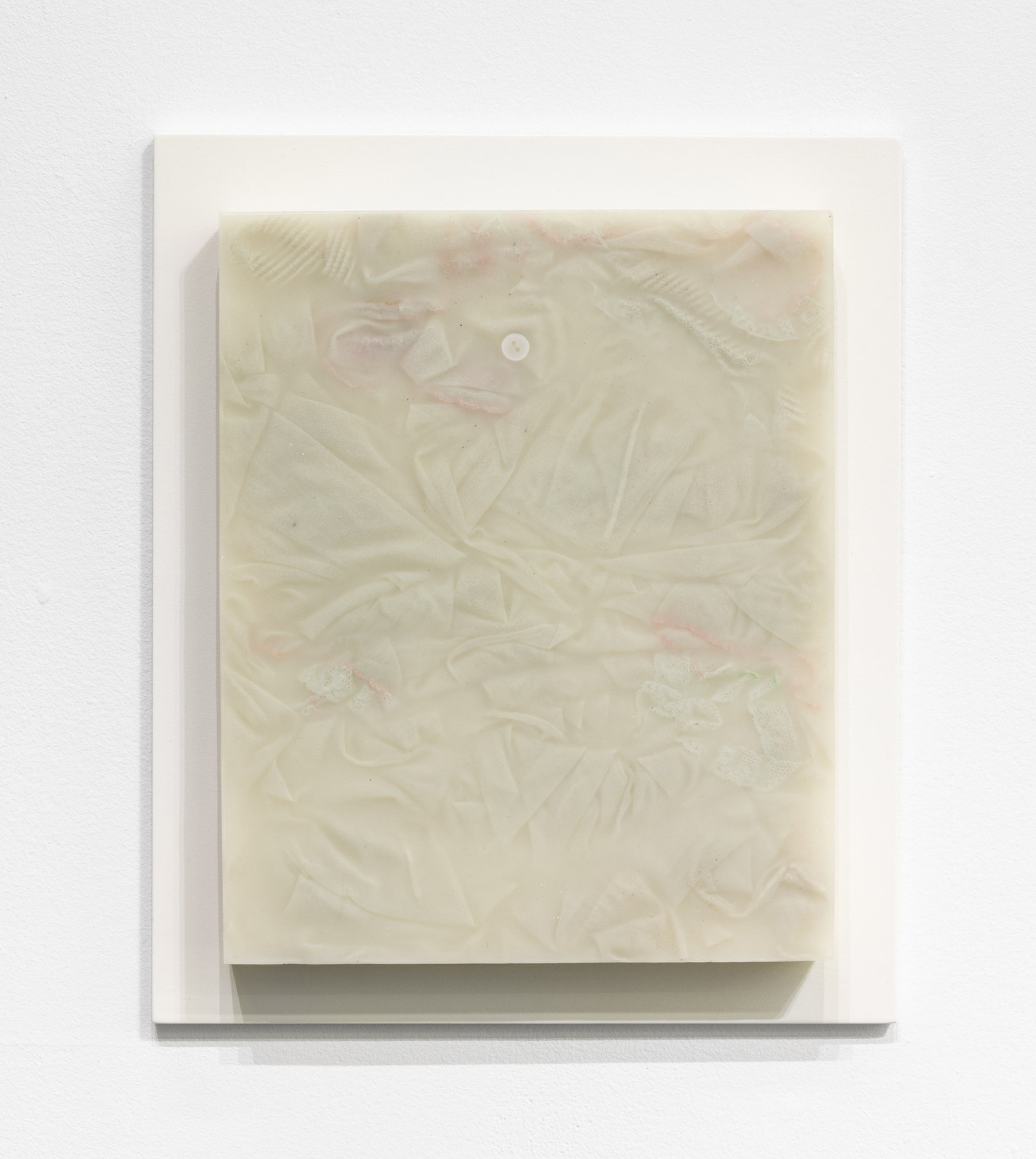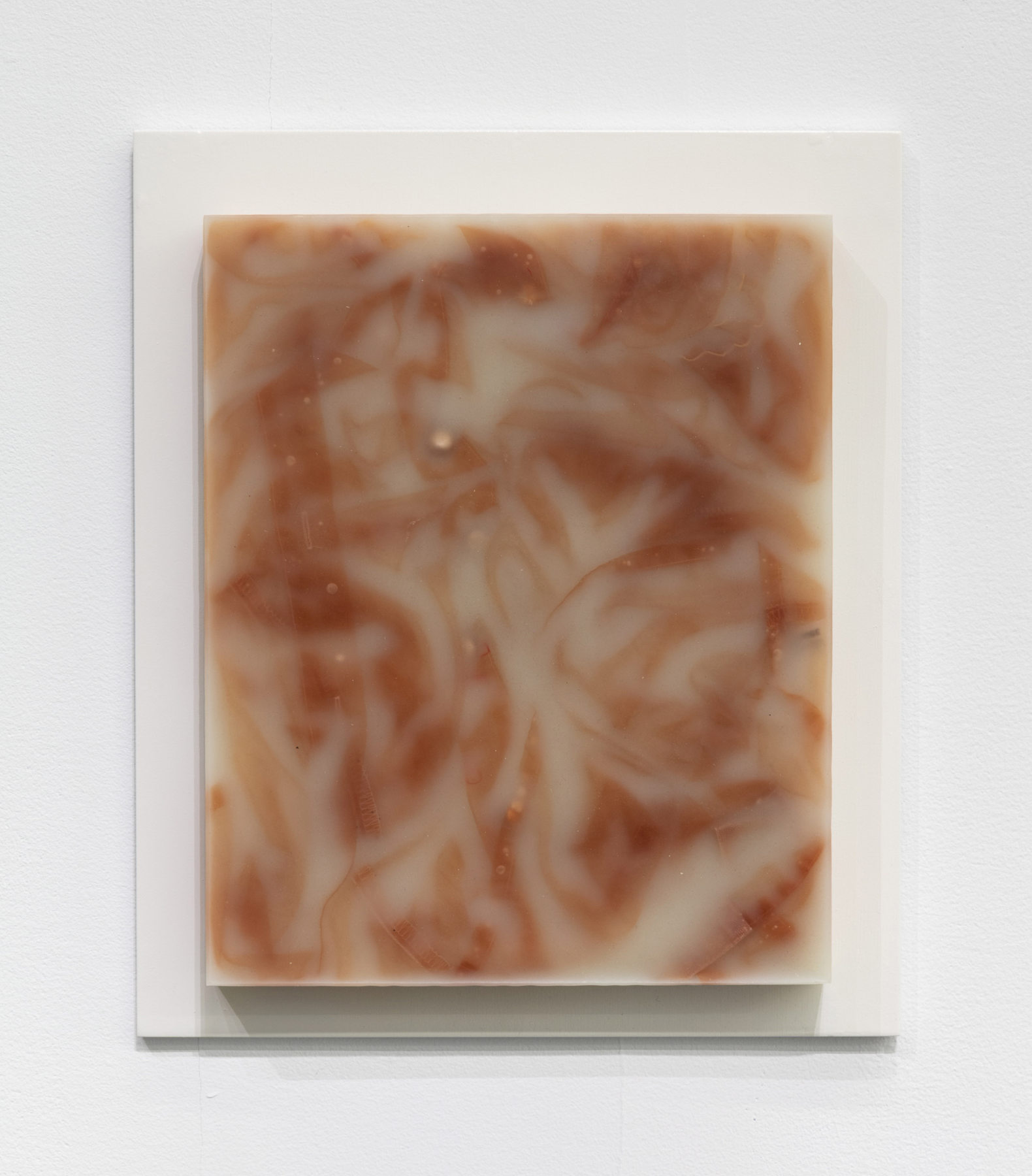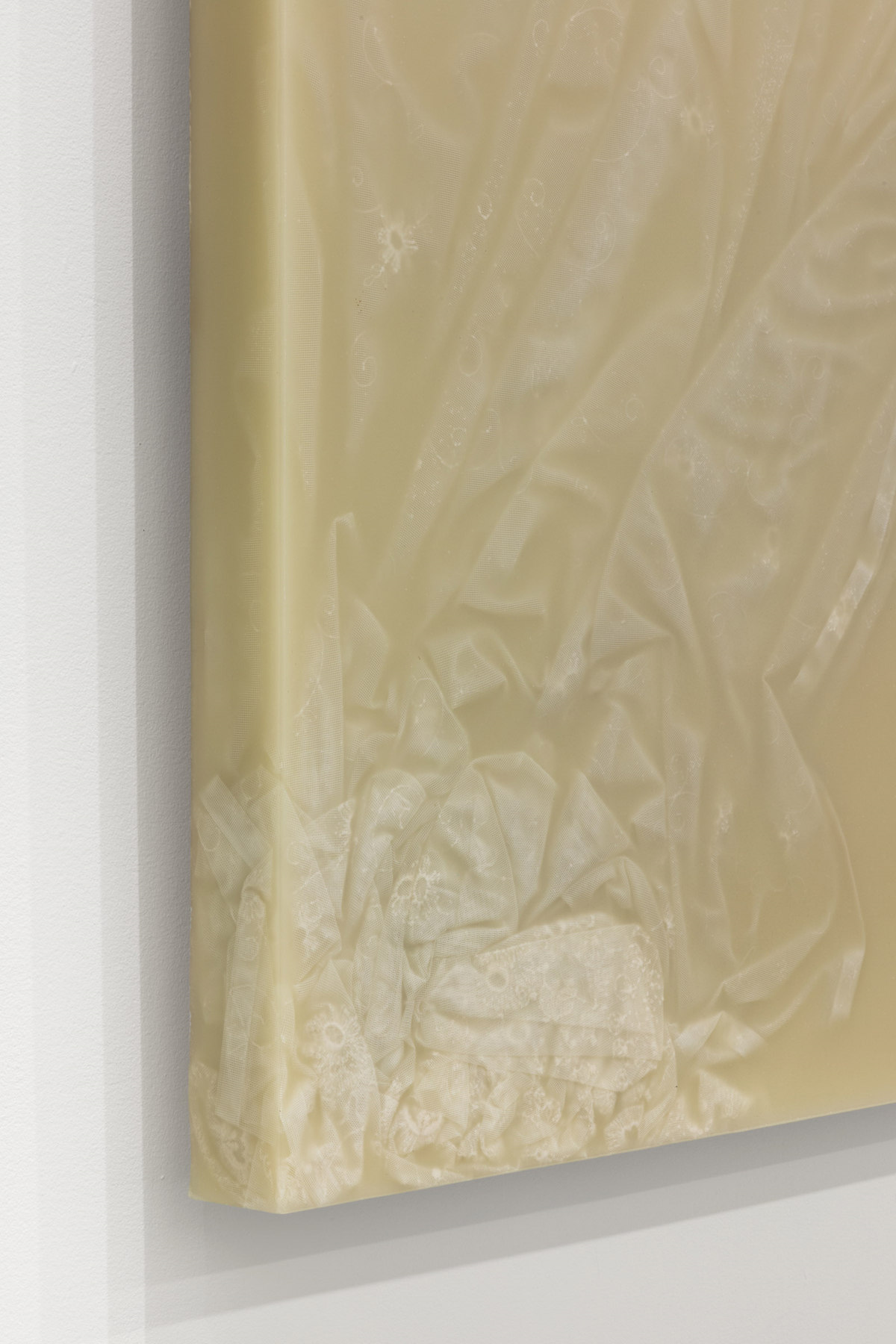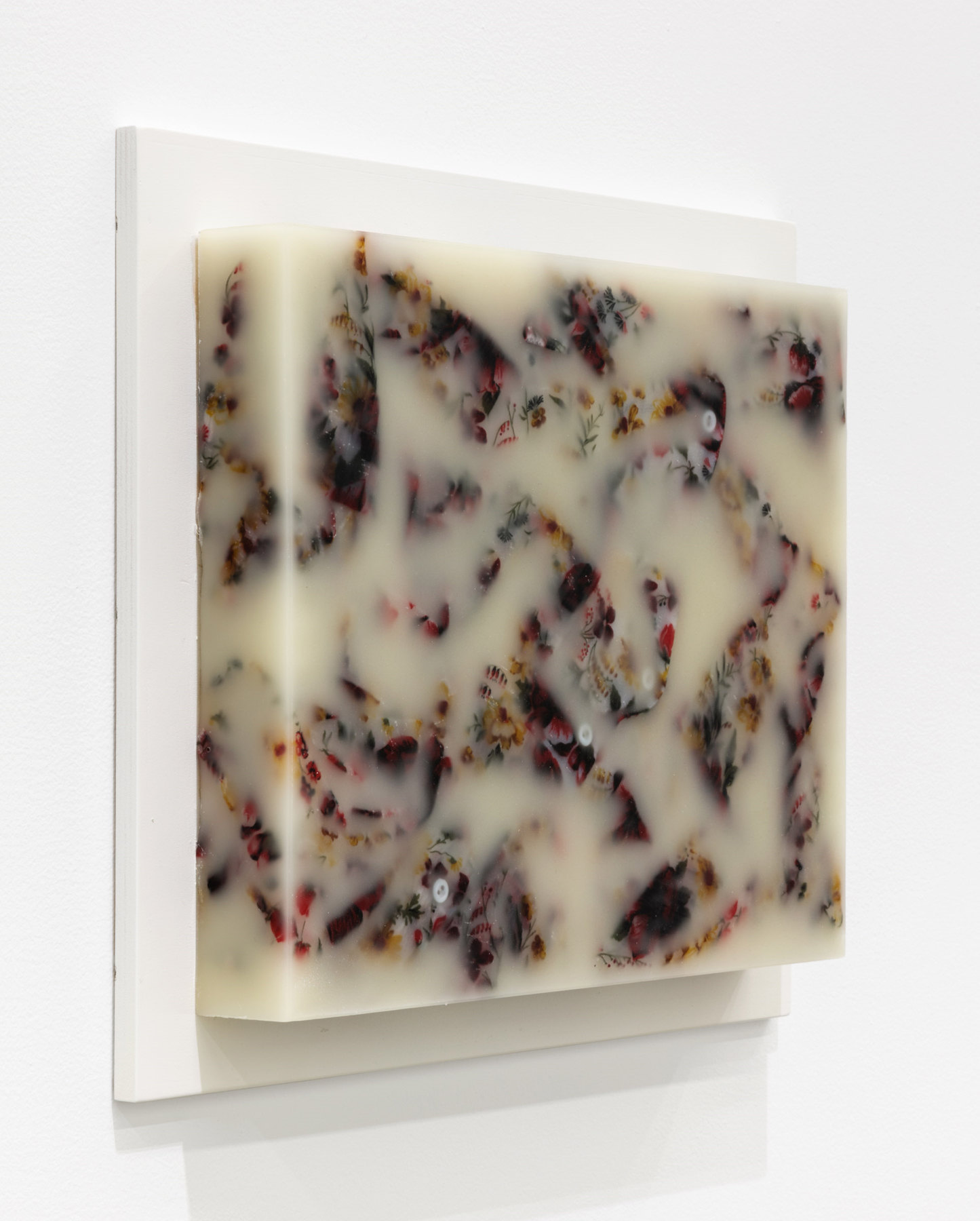Artist: Iris Häussler
Exhibition title: Lost Gazes: Wax Works From the 1990s
Venue: Daniel Faria Gallery, Toronto, Canada
Date: February 13 – April 6, 2019
Photography: all images copyright and courtesy of the artist and Daniel Faria Gallery, Toronto
Articles of laundry appear in many of Iris Häussler’s works, in particular laundry which would come in direct contact to a person’s skin, such as bed linen, towels, sleepwear and underclothing. Where the bed linen and towels played a certain role in her early hotel works (1995) and in “Xenotope” (the inversion of a hotel work where guests could spend the night at different art-institutions sleeping in the exhibition rooms), underclothing is a central point in another body of work: Haussler’s works with wax.
Here, the articles of clothing are set in blocks of wax of varying formats – a process of conservation with an amazing effect. Because, depending on the qualities of the fabric and the random effect caused by the fluid wax meeting with the soft fabric, very different works come about. In some, the used piece of clothing, for example, a child’s undershirt, is completely recognizable right down to the label. In others however, it is so abstracted that surprising painterly effects occur, almost as though it were a study of a baroque garment or even an abstract painting. Seen together however, all the works are an antinomy of distance and nearness. The wax not only takes away the accessibility of the article, but also sometimes its visible shape. It nearly disappears into the depth of the block of wax – like an object fallen into a deep body of water and as it sinks deeper, becomes less and less visible. On the other hand, there is the intimacy of the article of clothing that at one point had warmed and protected the body of a person and was once close to their skin. The intimate quality of the piece of clothing points to the skin being a border between the inner and outer sides of a person. Then, in another sense, it points exactly to the borders between the private and the public, to the nearness and distance that Iris Häussler examines and delves into. At the same time, it is clear that the clothing possesses a face that is linked to the biography of a person about whom the viewer learns nothing more. The titles of the wax works also hint at this biographical aspect. They are called “Kind” (“Child”), “Schwester” (“Sister”), “Onkel” (“Uncle”) or “Mutter” (“Mother”), so that the work is bound to a grid of familial relationships and dependencies.
Iris Häussler has preserved other objects that represent the biography of one or more people, such as mattresses, curtains or letters, and removed their direct accessibility. This method is equally attached to an unsettling vulnerability. Wax is highly sensitive to outer forces: to heat, which melts it, and to touch, which leaves behind traces and imprints. This could be a hint at human existence, whose relics are enclosed by the wax, being extremely fragile. An example of this is an exhibition that Iris Häussler realized in Potsdam in 1995 which points to this idea. Under the title “Leihgaben” (“On Loan”), she presented articles of laundry that came from public institutions. The type of institutions to which people are usually committed against their will and for existential reasons: hospitals, prisons and orphanages. The laundry doesn’t speak of the fates of those that wore or would wear them after the exhibition, but they communicate a spectrum of human fate in which a single moment suffices to destroy or radically change the existence of a human being. Häussler in a sense creates a contemporary memento mori that makes the viewer poignantly aware of the temporality of one’s own existence and the dangers to which they are exposed.
Therefore, it is the person – as Iris Häussler has said – who is the central issue in her work, and not herself. There have always been distancing instances interposed in the form of substitutes, the fictive people or their personal articles in “fictive legacies”, and the pieces of clothing in the wax work. These substitutes enable Iris Häussler to construct and visualize the most intimate life situations without actually harming the privacy of a person. They enable her to experiment with different forms of acts, in which the borders between the everyday and art, normalcy and manic behaviour, are unnervingly similar, as in the films of David Lynch. The substitutes enable the existential issues, to be understood as exemplary and then: the substitutes enable Iris Häussler to carry out her own artistic endeavours almost as detached work. Her experimental formations and her quasi-scientific methods contain, at the core, questions of the possibilities and boundaries of an artist’s work, and with that, of the role of the artist in today’s society. Clearly, the answer to this question does not come easily, but rather a spectrum is demonstrated in which, through the fictional and subversive interventions, a scope of action is opened, not only for the possible user, but also for the artist herself. Consequently, Iris Häussler’s work proves to be not least a research into itself: research into art.*
-Martina Fuchs, 2000
*Adapted from the text “Distance From the Alien Work. On the Work of Iris Häussler” by Martina Fuchs (translated by Laura Bruce). This text was originally published in Iris Häussler: It Wasn’t Me. (Fuchs, Martina. It Wasn’t Me, ISART Galerie, Westermühlstraße, Munich. 2001.).
Iris Häussler (b. 1962) studied at the Munich Academy of Fine Arts. Her work has been the subject of solo shows, including The Sophie La Rosière Project, a three-part exhibition shared between the Art Gallery of York University (2016), Scrap Metal Gallery (2016), and Daniel Faria Gallery (2017), He Named Her Amber at the Art Gallery of Ontario, Toronto (2008-10), and most recently Apartment 4 and Tale of Two at the John Michael Kohler Arts Center, Sheboygan (2018). Group exhibitions include Groupe Mobile at Villa Vassilieff, Paris (2016); Somebody Everybody Nobody, Scrap Metal Gallery, Toronto (2015); Kunst Oberschwaben 20. Jahrhundert: 197- bis heute, at Museum Villa Rot in Burgrieden, Germany (2014); More Real? Art in the Age of Truthiness, Minneapolis Institute of Arts, Minneapolis, and SITE Santa Fe, USA (2013); and All Our Relations, The 18th Biennale of Sydney, Australia (2012). Häussler has been the recipient of numerous grants including the Toronto Arts Council, the Ontario Arts Council, and the Canada Council for the Arts. Her works can be found in the collections of the Art Gallery of Ontario (Toronto), Städtische Sammlung in Lenbachhaus (Munich), Goetz Collection (Munich) and the Collection Opitz-Hoffman (Bonn).
Iris Häussler, Lost Gazes: Wax Works From the 1990s, 2019, exhibition view, Daniel Faria Gallery, Toronto
Iris Häussler, Lost Gazes: Wax Works From the 1990s, 2019, exhibition view, Daniel Faria Gallery, Toronto
Iris Häussler, Lost Gazes: Wax Works From the 1990s, 2019, exhibition view, Daniel Faria Gallery, Toronto
Iris Häussler, Lost Gazes: Wax Works From the 1990s, 2019, exhibition view, Daniel Faria Gallery, Toronto
Iris Häussler, Lost Gazes: Wax Works From the 1990s, 2019, exhibition view, Daniel Faria Gallery, Toronto
Iris Häussler, Lost Gazes: Wax Works From the 1990s, 2019, exhibition view, Daniel Faria Gallery, Toronto
Iris Häussler, Lost Gazes: Wax Works From the 1990s, 2019, exhibition view, Daniel Faria Gallery, Toronto
Iris Häussler, Lost Gazes: Wax Works From the 1990s, 2019, exhibition view, Daniel Faria Gallery, Toronto
Iris Häussler, Lost Gazes: Wax Works From the 1990s, 2019, exhibition view, Daniel Faria Gallery, Toronto
Iris Häussler, Lost Gazes: Wax Works From the 1990s, 2019, exhibition view, Daniel Faria Gallery, Toronto
Iris Häussler, Lost Gazes: Wax Works From the 1990s, 2019, exhibition view, Daniel Faria Gallery, Toronto
Iris Häussler, Lost Gazes: Wax Works From the 1990s, 2019, exhibition view, Daniel Faria Gallery, Toronto
Iris Häussler, Lost Gazes: Wax Works From the 1990s, 2019, exhibition view, Daniel Faria Gallery, Toronto
Iris Häussler, Lost Gazes: Wax Works From the 1990s, 2019, exhibition view, Daniel Faria Gallery, Toronto
Iris Häussler, Lost Gazes: Wax Works From the 1990s, 2019, exhibition view, Daniel Faria Gallery, Toronto
Iris Häussler, Lost Gazes: Wax Works From the 1990s, 2019, exhibition view, Daniel Faria Gallery, Toronto
Iris Häussler, Lost Gazes: Wax Works From the 1990s, 2019, exhibition view, Daniel Faria Gallery, Toronto
Iris Häussler, Lost Gazes: Wax Works From the 1990s, 2019, exhibition view, Daniel Faria Gallery, Toronto
Iris Häussler, Dokumentenkoffer (Suitcase For Documents), 1999, Found suitcase, wax, newsprint, 12” x 16 ½” x 19”
Iris Häussler, Dokumentenkoffer (Suitcase For Documents), 1999, Found suitcase, wax, newsprint, 12” x 16 ½” x 19”
Iris Häussler, Dokumentenkoffer (Suitcase For Documents), 1999, Found suitcase, wax, newsprint, 12” x 16 ½” x 19”
Iris Häussler, Schwester (Sister), 1997, 12 ½” x 10 ¼”, Fabric, wax
Iris Häussler, Schwester (Sister), 1997, 12 ½” x 10 ¼”, Fabric, wax
Iris Häussler, Mutter (Mother), 1998, 12 ¾” x 10 ¼”, Fabric, wax
Iris Häussler, Mutter (Mother), 1998, 12 ¾” x 10 ¼”, Fabric, wax
Iris Häussler, Verlorene Blicke (Lost Gazes), 2000, Curtain, wax, 35 ½” x 39 ½”
Iris Häussler, Verlorene Blicke (Lost Gazes), 2000, Curtain, wax, 35 ½” x 39 ½”
Iris Häussler, Verlorene Blicke (Lost Gazes), 2000, Curtain, wax, 35 ½” x 39 ½”
Iris Häussler, Verlorene Blicke (Lost Gazes), 2001, Curtain, wax, 39 ½” x 35 ½”
Iris Häussler, Verlorene Blicke (Lost Gazes), 2001, Curtain, wax, 39 ½” x 35 ½”
Iris Häussler, Verlorene Blicke (Lost Gazes), 2001, Curtain, wax, 39 ½” x 35 ½”
Iris Häussler, Verlorene Blicke (Lost Gazes), 2001, Curtain, wax, 31 ½” x 21 ½”
Iris Häussler, Verlorene Blicke (Lost Gazes), 2001, Curtain, wax, 31 ½” x 21 ½”
Iris Häussler, Verlorene Blicke (Lost Gazes), 2000, Curtain, wax, 31 ¼” x 23 ¾”
Iris Häussler, Verlorene Blicke (Lost Gazes), 2000, Curtain, wax, 31 ¼” x 23 ¾”
Iris Häussler, Verlorene Blicke (Lost Gazes), 2001, Curtain, wax, 38” x 17 ½”
Iris Häussler, Verlorene Blicke (Lost Gazes), 2001, Curtain, wax, 38” x 17 ½”
Iris Häussler, Tochter der Schwester Der Mutter (Niece), 1999, Fabric, wax, 12 ½” x 15 ¾”
Iris Häussler, Tochter der Schwester Der Mutter (Niece), 1999, Fabric, wax, 12 ½” x 15 ¾”
Iris Häussler, Gross-tante (Great Aunt), 1999, 12 ½” x 10 ¼”, Fabric, wax
Iris Häussler, Gross-tante (Great Aunt), 1999, 12 ½” x 10 ¼”, Fabric, wax
Iris Häussler, Schwester (Sister), 1998, Fabric, wax, 12 ½” x 10 ¼”
Iris Häussler, Schwester (Sister), 1998, Fabric, wax, 12 ½” x 10 ¼”
Iris Häussler, Schwester des Vaters (Father’s Sister), 1998, Fabric, wax, 12 ½” x 10 ¼”
Iris Häussler, Schwester des Vaters (Father’s Sister), 1998, Fabric, wax, 12 ½” x 10 ¼”
Iris Häussler, Cousine des Vaters (Father’s Cousin), 1999, Fabric, wax, 12 ¼” x 15 ¾”
Iris Häussler, Cousine des Vaters (Father’s Cousin), 1999, Fabric, wax, 12 ¼” x 15 ¾”
Iris Häussler, Gross-tante (Great Aunt), 1998, Fabric, wax, 12 ¼” x 15 ¾”
Iris Häussler, Gross-tante (Great Aunt), 1998, Fabric, wax, 12 ¼” x 15 ¾”
Iris Häussler, Mutter (Mother), 1998, Fabric, wax, 12 ¼” x 15 ¾”
Iris Häussler, Mutter (Mother), 1998, Fabric, wax, 12 ¼” x 15 ¾”
Iris Häussler, Schwester (Sister), 1998, Fabric, wax, 12 ¼” x 15 ¾”
Iris Häussler, Schwester (Sister), 1998, Fabric, wax, 12 ¼” x 15 ¾”
Iris Häussler, Mutter des Vaters (Father’s Mother), 1999, Fabric, wax, 12 ¼” x 15 ¾”
Iris Häussler, Mutter des Vaters (Father’s Mother), 1999, Fabric, wax, 12 ¼” x 15 ¾”























































